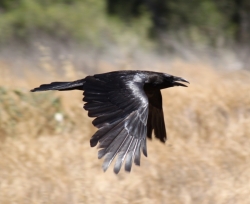
By Greg Dunne
August 10, 2014 (San Diego’s East County)--The Raven has such an undeserved reputation--always associated with darkness, despair, death. Right away one thinks of Ravens and Alfred Hitchcock, the Addams family, or Edgar Allan Poe’s poem “The Raven” and the movies inspired by Poe’s poetry, the 1935 classic “The Raven” starting Boris Karloff and Bela Lugosi. The list of Raven influence and culture is endless.
 However, this is one of the smartest animals on the planet. Let’s take a look at the keen and sharp side of the Raven. The Raven is my wildlife friend; a bit more on that towards the end.
However, this is one of the smartest animals on the planet. Let’s take a look at the keen and sharp side of the Raven. The Raven is my wildlife friend; a bit more on that towards the end.
Some of you might not know, but Ravens and Crows (same family – Corvidae and same genus Corvus) are among of the most intelligent animals in the world! They rank in the top 10 of the majority of scientific studies of animal intelligence, able to solve difficult puzzles and problems for food and a memory for facial recognition.
One of my favorite studies is of Crows and Ravens given peanuts in the middle of the street just before a lighted intersection. After a while both were able to understand and recognize when the street light turned in their favor and that’s when they would get in the road to pick up their peanut reward.
 The Common Raven is a truly acrobatic flier. Not many people get to witness this because most of us see Ravens in parks, downtown, and in the midst of residential areas. They like to hop around at parks looking for something to eat, or looking for mischief to get into. However, they are truly one of the most graceful and acrobatic flyers in the bird kingdom--often doing rolls and somersaults in the air, chasing off birds of prey with great dives and hard midair turns. One Raven was seen flying upside down for more than a half-mile!
The Common Raven is a truly acrobatic flier. Not many people get to witness this because most of us see Ravens in parks, downtown, and in the midst of residential areas. They like to hop around at parks looking for something to eat, or looking for mischief to get into. However, they are truly one of the most graceful and acrobatic flyers in the bird kingdom--often doing rolls and somersaults in the air, chasing off birds of prey with great dives and hard midair turns. One Raven was seen flying upside down for more than a half-mile!
In addition, the Raven’s intelligence makes these birds very successful predators, working in pairs to raid seabird colonies – with one bird distracting an incubating adult and the other waiting to grab an egg or chick as soon as it’s uncovered. They have been seen waiting in trees while ewes (female sheep) give birth, then attacking the newborn lambs. Maybe there is a dark side to the Raven. But we see this in nature with most predators.
The Raven is the largest songbird. Its ability to communicate between themselves is remarkable. Through its calls, it can communicate warning, threats, taunting, and even cheer other birds. Over 20 distinct patterns of calls have been interpreted by researchers.
Ravens also make sophisticated nonvocal signals. They gesture and point with their beaks to indicate an object to another bird, just as we do with our fingers. In primates this has been observed, but not in any other animal species. And I feel I have a communication with the Ravens when I’m on my weekly hikes.
I hike weekly, almost at the same time each day. I wear the same shirt, same ball cap and I love seeing “my” Ravens on my hikes.
Do the Ravens recognize me? I think they do; I recognize them. When they start calling and chattering above I’ll stop walking, tip my hat to them and give a call out. I try to give a Raven cackle but it’s a feeble attempt and I think they get a kick out of it. I can’t help but notice this is a bird with leisure time on its hands, giving me arial shows as I sit and watch with amazement on top of North Fortuna in Mission Trails.
We often underestimate the intelligence of nature; I believe this to be a mistake. There is still much to learn about nature and it’s interaction within itself and its surroundings. Thanks Ravens, until we meet again.







Recent comments